The best laid plans of mice and men and women go awry. And so it was when I booked an AirBnB for me and my son Alun to stay so we could hike in Carmanah Walbran Provincial Park and also see Big Lonely Doug, the single Douglas-fir left to stand among a valley of very young planted trees in what was once a clearcut. Alun works in the Canadian forestry industry, so he was as keen as me to see the trees.
In the end, though, we saw neither the Park nor Lonely Doug, but we saw much more and we remembered family.
Day One: Goldstream Provincial Park
I remember accompanying my parents to Goldstream Provincial Park when I lived in and around Victoria in the mid-1980s. We saw salmon—perhaps chum, coho, or chinook salmon—returning from the ocean to reach their spawning grounds on Goldstream River. My father was a fly fisherman; he was in awe of the trees, the river, and, especially, the salmon. I learned lots about salmon when I began working in Communications for Fisheries and Oceans Canada, sixteen years later.
When my son and I returned to Goldstream this May 2025, it was the wrong time of year for the salmon to be running of course, but I was just as much in awe of the wonderful trees as my father had been.
Here, a bigleaf maple has found its soil in a western redcedar stump.And what else is that growing out of its base?
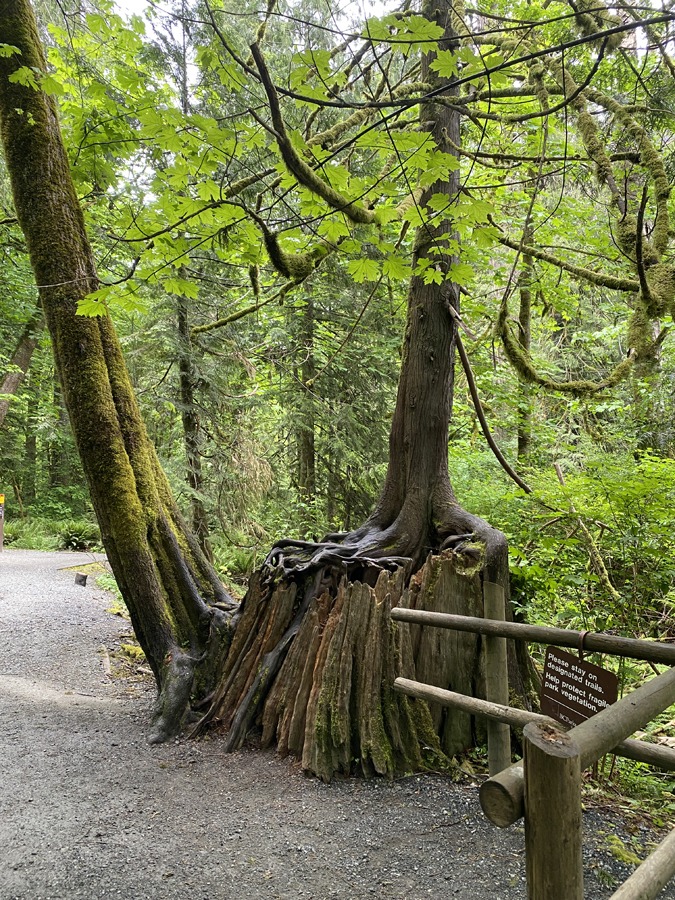
We went on to our AirBnB near the town of Lake Cowichan. Here is Josiah Creek, gurgling and rippling over rocks and curving around the property’s river bank.

My son was able to follow the Visitor Information Centre’s recommended route, which included driving three sides of a square to avoid a washed-out bridge so we could get near the Red Creek Fir—another Douglas-fir. We found some kind of indication that we had arrived at the path and then we walked. The trail was easy this time. What a relief. It took us past three Western redcedars, and through ferns, salmonberryand thimbleberry bushes, and trilliums. And something like chanterelles, but maybe not. We left them there.
Day Two: Harris Creek Sitka Spruce
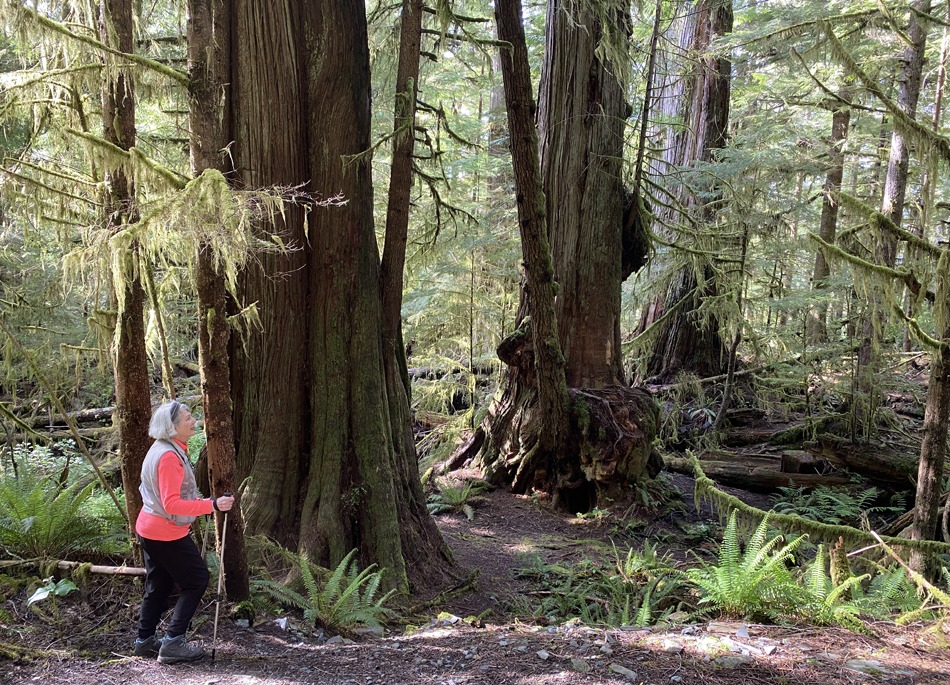
On the way from Lake Cowichan to Port Renfrew, we saw trees draped in the lichen known as witch’s hair, Alectoria sarmentosa. This lichen is native to northern temperate rainforests, like this rainforest on the southwest coast of Vancouver Island.
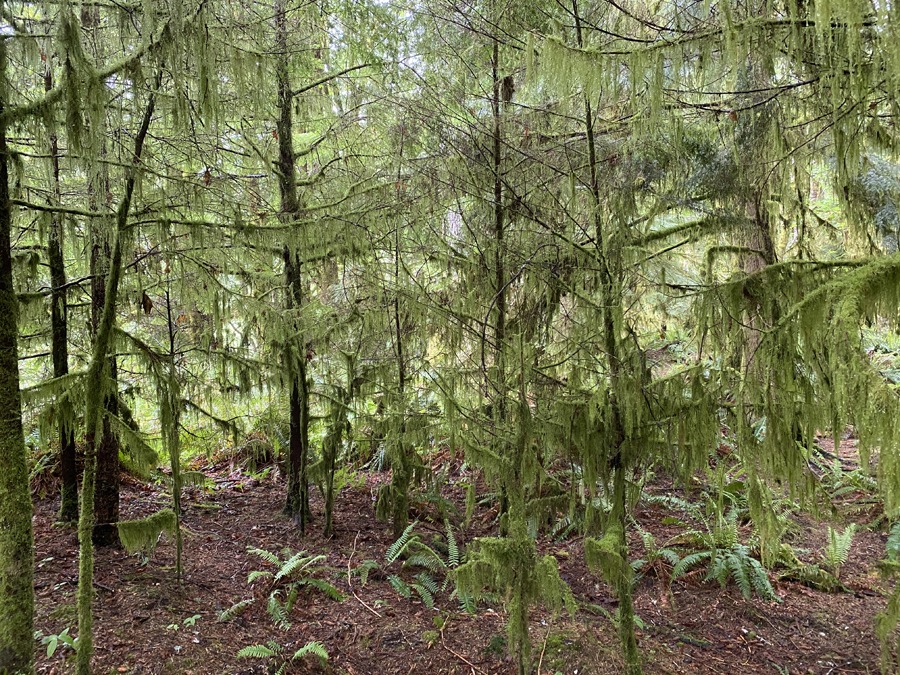
We stopped to admire the Harris Creek Sitka Spruce, one of the biggest sitka spruces around. It is now a BC Heritage Tree, listed on the University of British Columbia’s Faculty of Forests BC BigTree Website at https://bigtrees.forestry.ubc.ca/.
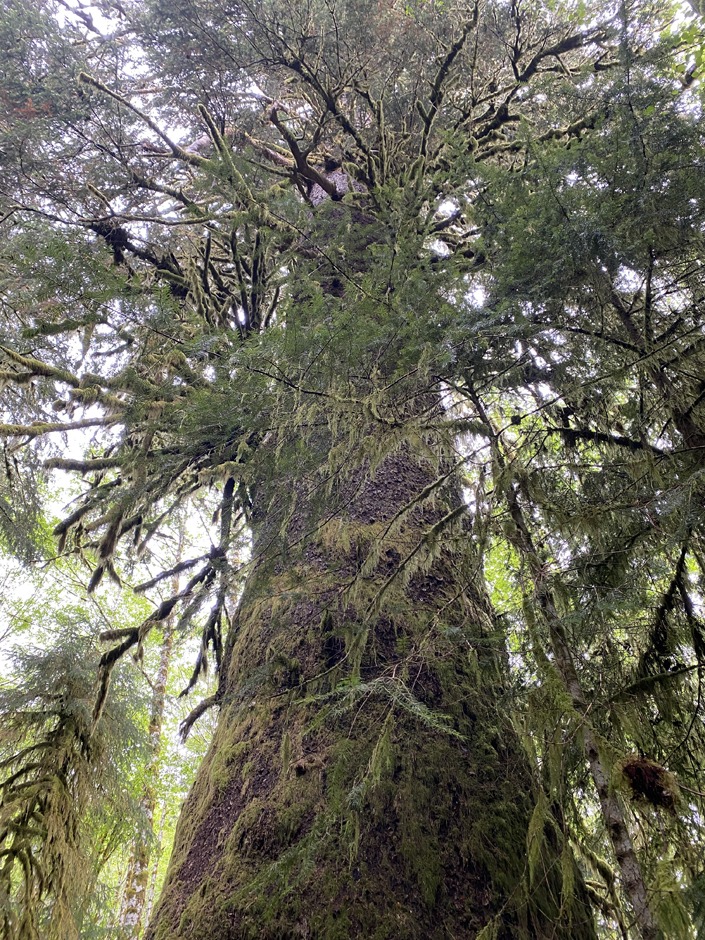
Botany Bay to Botanical Beach
From Port Renfrew, we drove the short distance to Botany Bay in Juan de Fuca Park on the Pacific Ocean, and were astonished to find the parking lot absolutely heaving. But we were too eager to get to the ocean to wonder why. We went down an easy trail and there, a windswept Sitka spruce was merely surviving in the occasional gales blowing from the west entrance of Juan de Fuca Strait. Year after year it grows old in krummholz form.

We could see people all over a beach to our east. The beach seemed quite near. Between salal growing tall and shrubby and trees struggling to hold on, we walked part of the Juan de Fuca Trail, from Botany Bay to Botanical Beach, via the very challenging (to me) Botanical Loop Trail. Every few steps, there were tree roots to climb over, muddy puddles to tread through, and occasionally concrete slabs to negotiate. It was a very long thirty-minute hike.
Finally, we reached the sandy beach and I found a log to sit on to recover while my son strode to the bluff’s edge to photograph huge Pacificwaves dashing against the rocks. Near me, people were lassoing lengths of bull kelp around themselves. And I learned that this was the first time when a low ocean tide had coincided with a long weekend in over a year. People had driven in from far afield because at low tide the tidal pools at Botanical Beach are shallow enough to see into, and are filled with not just barnacles, mussels, and limpets but chitons, sea anemones, various seaweeds, and much more. No wonder the parking lot was overflowing.
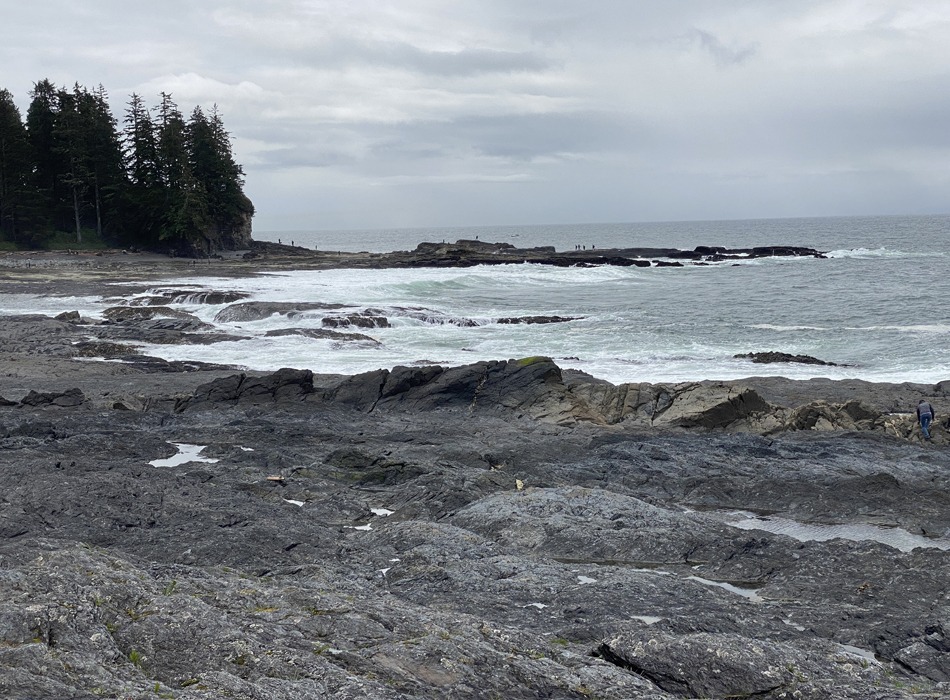
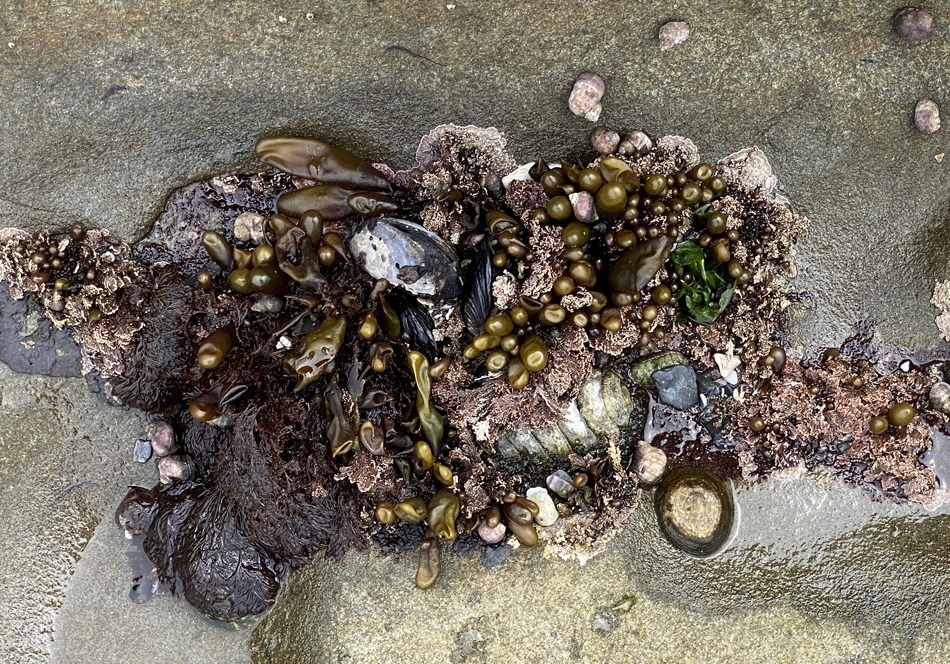
Some Record-Breaking Native Trees
The couple working at the Visitor Information Centre in Port Renfrew advised us against trekking to Big Lonely Doug because of the challenges of the logging road there, and instead recommended driving and then walking the short and easy trail to the “World’s Largest” Douglas-fir. We liked the idea.
First we saw the bonsai tree growing in Fairy Lake. It is a Douglas-firand it’s growing out of a submerged Douglas-fir log. I wonder for how long!


Then we were at the “World’s Largest” Douglas-fir. According to the sign nearby and ignoring the fact that it may have grown since, this Douglas-fir’s measurements were diameter 4.2 m and height 73.8 m. Big Loney Doug has a diameter of 3.91 m and height 70.2 m. Both are mammoth trees.

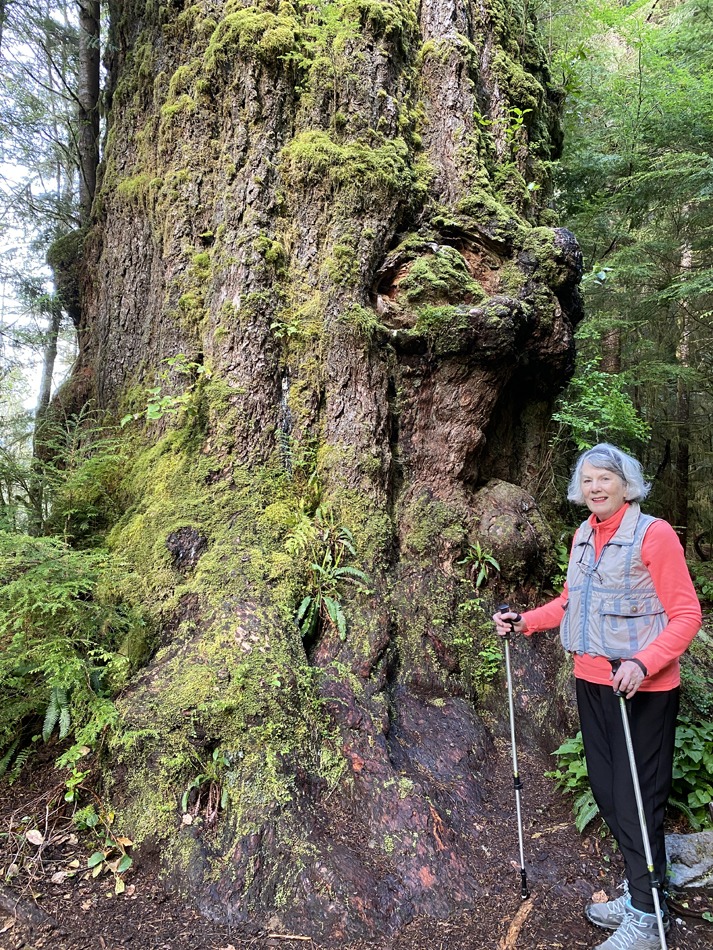
On the way back to the truck, we stopped to admire the San Juan Spruce, a Sitka spruce that had lost some of its top during a winter storm.Still impressive.
Day Three: Honeymoon Bay Ecological Reserve
See blog post dated June 2, 2025 (https://naturevancouver.ca/walking-a-loop-trail-through-honeymoon-bay-ecological-reserve/) on Nature Vancouver’s website for what we saw inside the Honeymoon Bay Ecological Reserve on May 18.
Sites in Lake Cowichan
The Forest Workers Memorial Park is a space honouring those from Lake Cowichan who have worked in the forestry industry. After all, this part of the world is all about trees and rivers, lumber and fishing. Some native trees have been planted around the memorital.
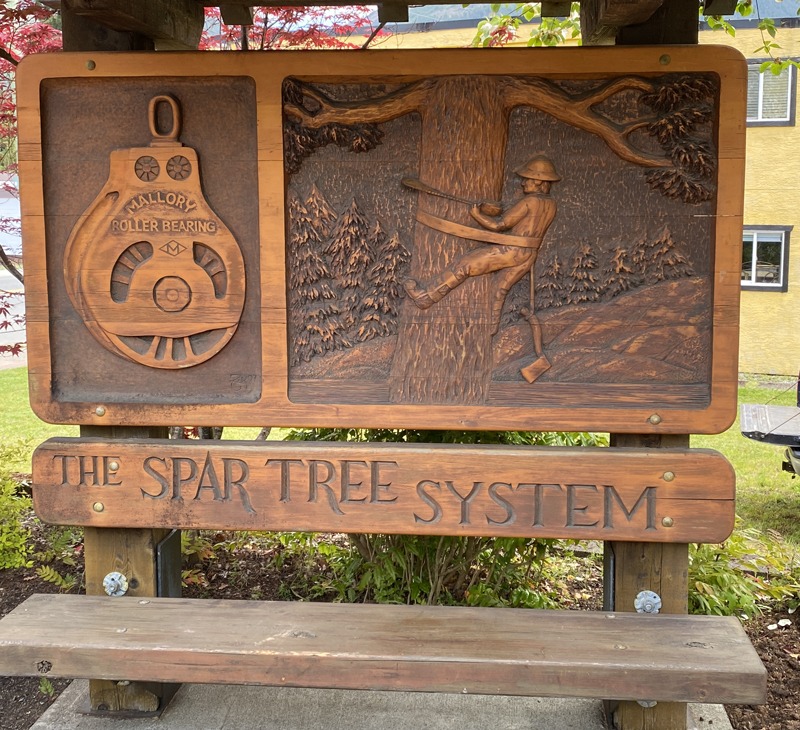
We also popped into the Cowichan Museum and saw some old logging equipment, including some double-handled crosscut saws, several painted with logging scenes, and a precursor to the modern chainsaw.
In 1989, Lake Cowichan and Ohtaki became twin towns. Ohtaki inJapan is an hour from Kawasaki away via road and toll bridge over Tokyo Bay. My sister lived in Lake Cowichan when the towns became twins and she visited the town of Ohtaki soon after the twinning. Alun and I passed the house where she used to live. It always was and is now even more so a riot of gorgeous plants: laburnum, wisteria, pines, a cherry tree, a dogwood, and much, much more. All of it protected by fencing from the black-tailed deer that are indigenous to Vancouver Island.
Skutz Fall and Fishway, and 66-Mile Trestle over Cowichan River
On our last afternoon, Alun and I went to see Skutz Fall and Fishway, and the 66-mile trestle bridge high above Cowichan River. What an undertaking to build such a bridge. Alun picked two leaves from a bigleaf maple and dropped them into the river. Letting them compete. First one. Then the other. Down, down, they went, until they landed gently on the river and floated away.
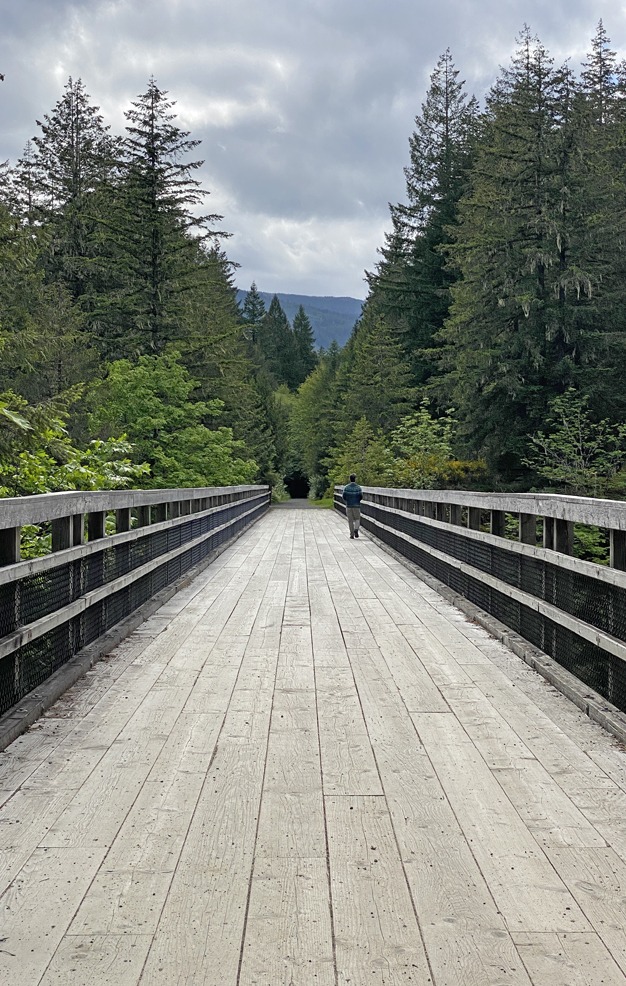

Day Four: Heading Home
We left the AirBnB at 6:30 a.m. for an early ferry back to the mainland and at that early hour when few humans were about, we saw black-tailed deer, an elk, and a brown bear. Farewell, Vancouver Island, until next time.
🖊️& 📷 by Nina S., Vancouver Master Gardener